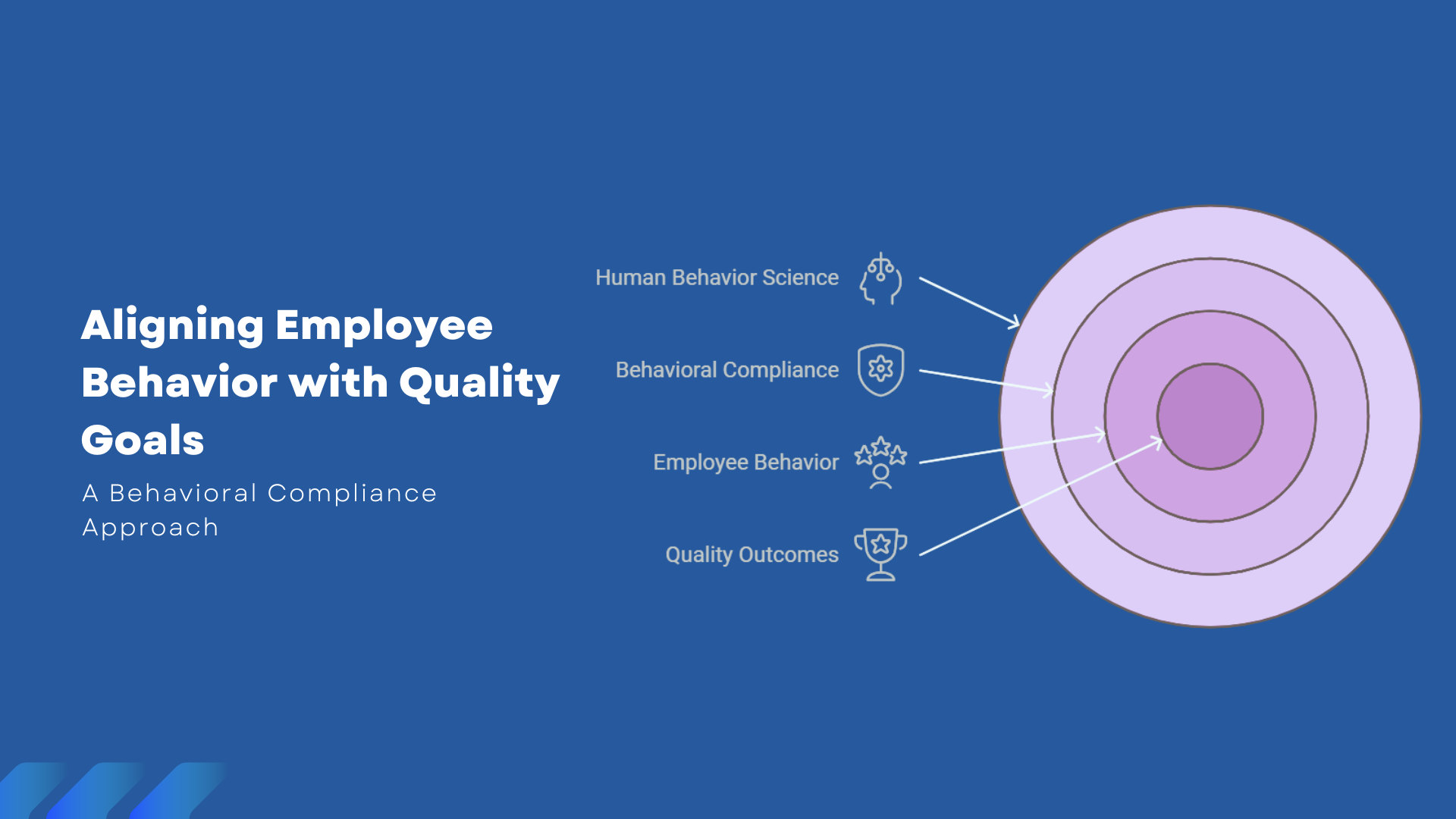When companies aim for high-quality results, the first instinct is often to invest in new technology, sophisticated systems, and detailed processes. Yet, despite all these efforts, many organizations still struggle with costly mistakes and compliance issues. So what’s missing?
The answer often lies in a less obvious factor: employee behavior. Even the most advanced systems will fall short if employees aren’t aligned with the company’s quality standards. This is where behavioral compliance comes in—a powerful approach that helps companies create a culture where employees naturally adhere to quality goals. Instead of relying on strict rules and enforcement, behavioral compliance taps into the science of human behavior to guide employees toward making the right choices every day.
Why Behavioral Compliance Is the Missing Piece
At its core, behavioral compliance uses insights from behavioral science to influence employee actions in a way that feels natural and non-intrusive. Unlike traditional compliance methods that often rely on mandates or punitive measures, behavioral compliance encourages employees to follow guidelines because they want to, not because they have to.
This approach is essential because it gets to the root causes of non-compliance. In many cases, employees don’t intentionally deviate from procedures—they may be confused, poorly trained, or working under misaligned incentives. Behavioral compliance helps companies address these issues by understanding what motivates employees and designing interventions that make compliance easier and more intuitive.
For example, instead of enforcing rules with penalties, a behavioral compliance approach might use positive reinforcement, real-time feedback, or reminders to help employees stay on track. By aligning employee behavior with company goals, businesses can create an environment where compliance is natural, leading to better performance and fewer mistakes.
Aligning Employee Behavior with Quality Goals
In industries like pharmaceuticals or manufacturing, even small deviations from standard operating procedures can lead to costly mistakes. The challenge isn’t just getting employees to know the rules—it’s ensuring that they consistently follow them. While traditional methods like written policies and periodic training are important, they often aren’t enough to drive real, long-term behavior change.
This is where behavioral compliance can make all the difference. It goes beyond simply telling employees what to do and focuses on helping them understand why their actions matter. More importantly, it makes compliance something employees want to do by making the right choices easier and more accessible.
Here’s how behavioral compliance works to align employee behavior with quality goals:
- Simplifying Compliance: Employees are more likely to follow through on quality standards when they are clear, accessible, and easy to follow. Providing simple, straightforward instructions and streamlining procedures can reduce the chance of errors.
- Leveraging Behavioral Science: By understanding the way employees make decisions, companies can design nudges and feedback systems that keep employees aligned with processes. For instance, providing immediate feedback when an employee veers off track can correct the mistake before it snowballs into a bigger issue.
- Reinforcing Positive Behavior: Recognizing and rewarding employees who follow quality standards encourages them to continue doing so. Positive reinforcement builds a culture of accountability where employees take ownership of their role in maintaining quality.
Practical Strategies for Aligning Employee Behavior
If your goal is to make quality compliance an effortless part of your employees’ daily routine, here are some practical strategies you can implement:
1. Behavioral Insights for Better Training
Traditional compliance training often falls short because it doesn’t take into account how adults learn and retain information. By incorporating behavioral insights into training programs, companies can create interactive, engaging learning experiences that reinforce the desired behaviors over time. Instead of one-time training sessions, continuous reinforcement—through reminders, quizzes, or hands-on practice—ensures employees stay sharp and compliant.
2. Aligning Performance Metrics with Quality Goals
When employees see that their performance reviews, bonuses, and promotions are directly tied to how well they adhere to quality standards, compliance becomes a personal priority. By linking employee success with the company’s quality goals, you create a stronger incentive for employees to stay compliant over the long term.
3. Fostering a Culture of Accountability
Building a culture where employees feel personally responsible for their actions starts at the top. Leadership must set clear expectations, demonstrate commitment to quality goals, and lead by example. When employees see that quality compliance is valued by leadership, they’re more likely to follow suit, ensuring a workplace where compliance is embedded in daily operations.
How SEEK Drives Behavioral Compliance
At SEEK, we recognize that aligning employee behavior with quality goals is critical to achieving sustainable organizational change. Our AI-powered platform uses behavioral science to continuously interact with employees, providing real-time insights into their behavior and delivering personalized nudges that encourage compliance.
By analyzing behavioral patterns, SEEK helps organizations identify the root causes of compliance gaps and implement solutions that drive long-term change. This approach not only corrects non-compliance but also ensures that employees are consistently aligned with quality goals.
In industries like pharmaceuticals and manufacturing, where even minor errors can lead to significant financial and reputational damage, SEEK has made a real difference. We’ve helped businesses achieve:
- Upto 60% reduction in human errors
- 40% increase in operational efficiency
- INR 6 Crore in cost savings through improved quality control
With SEEK, compliance becomes second nature to employees, ensuring that businesses meet their quality goals without the need for constant oversight.
Conclusion: Achieving Quality Goals Through Behavioral Compliance
Aligning employee behavior with quality goals is one of the most critical factors in ensuring organizational success. Traditional compliance methods, which rely on strict enforcement and penalties, can only go so far—they often fail to address the underlying behaviors that lead to non-compliance.
By adopting a behavioral compliance approach, organizations can ensure that employees not only understand the importance of quality but are also motivated to uphold these standards. This shift creates a work environment where compliance is a natural part of the daily routine, reducing errors and driving better outcomes.
At SEEK, we help businesses bridge the gap between compliance systems and employee behavior, using behavioral science to drive sustainable organizational change. Our platform empowers companies to meet their quality goals, making compliance effortless for employees.

